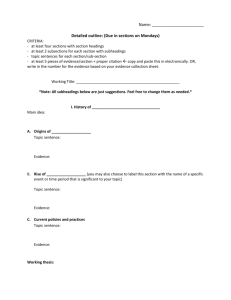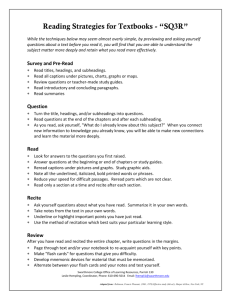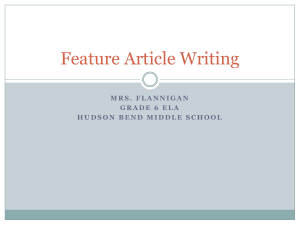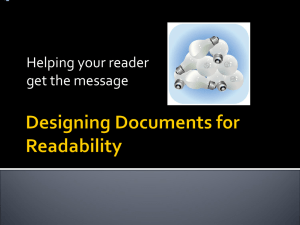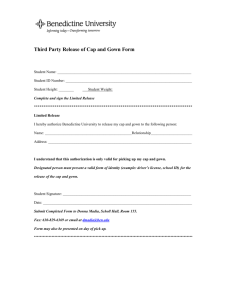CAP Analysis
advertisement
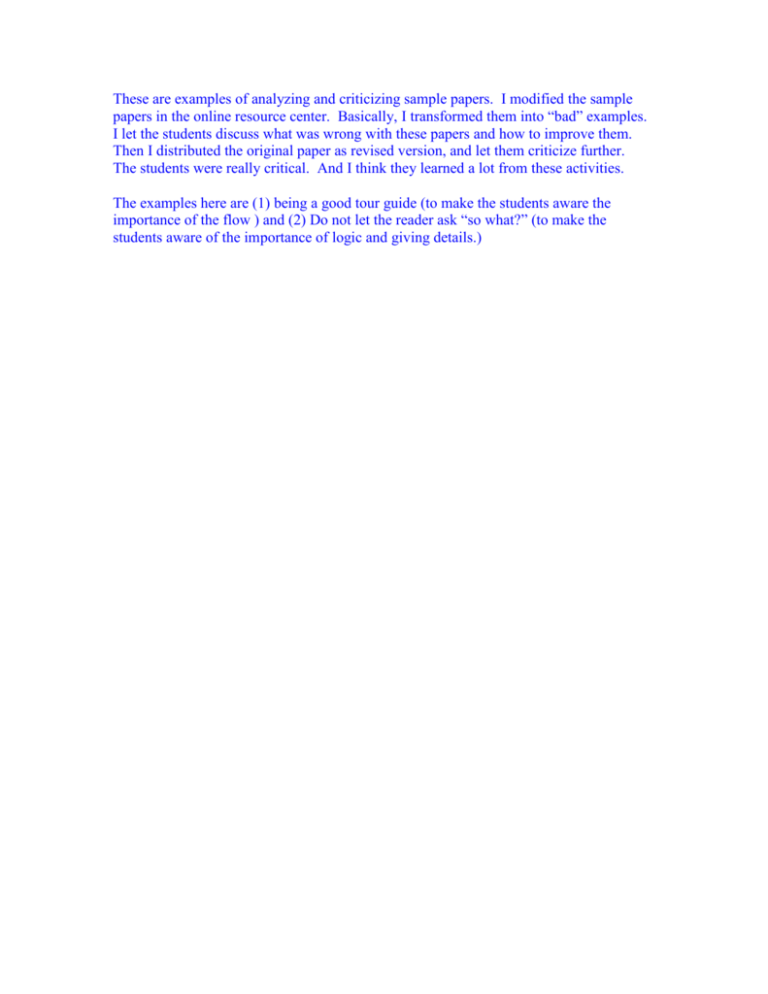
These are examples of analyzing and criticizing sample papers. I modified the sample papers in the online resource center. Basically, I transformed them into “bad” examples. I let the students discuss what was wrong with these papers and how to improve them. Then I distributed the original paper as revised version, and let them criticize further. The students were really critical. And I think they learned a lot from these activities. The examples here are (1) being a good tour guide (to make the students aware the importance of the flow ) and (2) Do not let the reader ask “so what?” (to make the students aware of the importance of logic and giving details.) Be a good tour guide! ELI 83 What do you think if a paper starts like this…..? CAP 2 Analysis of scholarly publications It was found that all the three paper follow the IMRD format very strictly, except that sometimes the result and discussion sections are combined together to form a single section. It was also found that titles of the three papers were very informative. Subject of paper is clearly stated in the title. The paper by Ohyama indicates the method in the title too. Thus, it is not difficult for a reader who has the background in fluid mechanics to guess the purposes of these papers only based on the titles. Informative as they are, these titles are not original. Neither the words nor the content of these titles are unusual in this field. Be a good tour guide! (2) ELI 83 Enough orientation before a tour? CAP 2 Analysis of scholarly publications Three journals, namely, Journal of Fluid Mechanics, Applied Ocean Research, and Ocean Engineering, were chosen for the preliminary study of CAP. For each journal, one paper was chosen as a sample. The three papers are shown as follows. Shankar, V., 2001, “Weakly nonlinear stability of viscous flow past a flexible surface”, J. of Fluid Mechanics, Vol.434, PP.337-354. Ohyama, T., 2000, “Modeling the floating-body motion in nonlinear random waves based on vertically integrated wave equations”, Applied Ocean Research, Vol.22, PP.155-167. Cheung, K.F., 2000, “Hydrodynamic response of a pneumatic floating platform”, Ocean Engineering, Vol.27, PP.1407-1440. The papers were analyzed and compared from three aspects, i.e., organization, purpose, and audience. While great similarities exist among these papers, the study also reveals that considerable difference exist at least in terms of the format of the papers and the audience. Organization of these papers was investigated first based on the overall format, meaning of title, method to divide into sections and other aspects. It was found that all the three paper follow the IMRD format very strictly, except that sometimes the result and discussion sections are combined together to form a single section. It was also found that titles of the three papers were very informative. Subject of paper is clearly stated in the title. The paper by Ohyama indicates the method in the title too. Thus, it is not difficult for a reader who has the background in fluid mechanics to guess the purposes of these papers only based on the titles. Informative as they are, these titles are not original. Neither the words nor the content of these titles are unusual in this field…….. ELI 83 Do not let the reader ask “so what?” CAP 4 Analysis of Student Paper (1) Smith, D., Cheung, K.F. (2001), Empirical relationships for grain parameters of calcareous sand on Oahu, Hawaii, Journal of Coastal Research, 18(1), 82-93 Wei, Y., Cheung, K.F., Curtis, G.D., & McCreery, C. (2001), Tsunami Height Forecast from Water-Level Data, Proceedings of MTS/IEEE Oceans 2001, Honolulu, Hawaii In Wei’s paper, the title says that the forecast was made based on the water-level data, which is the key information for this research. Similarly, in Smith’s paper, the words “Empirical” and “calcareous” appear in the title. “Empirical” describes both the method and limitation of the study. The adjective word “calcareous” also limits the range of the study since there are two other kinds of sands, which are basalt sand and lava-rock sand, in the island of Oahu except the calcareous sand. (2) Both of the papers use headings and subheadings to divide the text into sections. The headings are all in capital letters and have fonts that are much larger than the text. Only the first letters of the words, except prepositions, in the subheadings are capitalized. The fonts of the subheadings are slightly larger than the text. Like the papers for CAP 1, the words used in the headings are usually not as specific as those used in the subheadings. The reference format in Wei’s paper is not the exact APA format. First, there is a number at the beginning of each reference index. Second, the reference indexes are not in alphabetic order. The following two indexes indicate this. Like the papers for CAP 1, there are not citations or endnotes in the papers. Footnotes are very rare. There is only one footnote, which is in the first page of Smith’s paper. Each of the two papers contains two tables. The two tables in Smith’s paper are located in the result section. They show part of the records from the experiments. The two tables in Wei’s paper appear in the method section to present some information about the observation stations that provide the water-level data for the study. (3) Most of the figures are cited in the beginning of a sentence in a way like “Figure 1 shows …”. There are also some cases in which the citations of figures appear in the middle of sentences or the end of sentences. For example, “The results in Figure 41 indicate that…” or “the scatter of the data is approximately even throughout the settled sample as shown in Figure 8b.” The purpose paragraphs of the two papers also appear at the end of the introduction sections as the papers for CAP 1 do. The purpose sentences are located in the middle of the paragraphs instead of the initial position. The audiences of the two papers are the people who are working in the field of Ocean Engineering or those people whose businesses are related to Ocean Engineering. Especially for Wei’s paper, which deals with a practical problem and was proceeded in a conference, its audience may include some potential clients who may not have a strong academic background in this field. Discussion 0. Decide a discussion leader, a recorder, and a presenter. - A discussion leader facilitates discussion, elicit as many perspectives as possible, and summarize the discussion results -A recorder keeps the progress of the group discussion, prepare transparencies for a presentation. -A presenter presents the results of the discussion. 1. Are there any parts where you would like to ask “so what?” 2. Any suggestions to revise the paragraphs? (Compare the paragraphs with a revised version) 3. What are the differences between the original one and the revised version? 4. Why do you think the writer revised those parts? Are these revisions effective? In what way? 5. Are there any suggestions to make them even better? (Especially for the last paragraph) (Presentation) Please present results of your group discussion using transparencies. ELI 83 Do not let readers ask “So what?” Revisied Sample CAP 4 (1) There is not a collection of model papers in my department, Department of Ocean and Resources Engineering. Two doctoral students in the department, David Smith and Yong Wei, provided me with two papers that they feel most satisfied with. The two papers are shown as follows. Smith, D., Cheung, K.F. (2001), Empirical relationships for grain parameters of calcareous sand on Oahu, Hawaii, Journal of Coastal Research, 18(1), 82-93 Wei, Y., Cheung, K.F., Curtis, G.D., & McCreery, C. (2001), Tsunami Height Forecast from Water-Level Data, Proceedings of MTS/IEEE Oceans 2001, Honolulu, Hawaii The papers were analyzed with the same method that was used for CAP 1. Three aspects, i.e., organization, purpose, audience, were investigated. In addition, a comparison was made between the current papers and those used for CAP 1. There are some common characteristics in the titles of the two papers. Not only are the subjects clearly and concisely presented in the titles, but also the methods and limitations. For example, in Wei’s paper, the title says that the forecast was made based on the waterlevel data, which is the key information for this research. Similarly, in Smith’s paper, the words “Empirical” and “calcareous” appear in the title. “Empirical” describes both the method and limitation of the study. The adjective word “calcareous” also limits the range of the study since there are two other kinds of sands, which are basalt sand and lava-rock sand, in the island of Oahu except the calcareous sand. These characteristics also appear in the papers used in CAP 1. For example, in one of the paper “Modeling the floatingbody motion in nonlinear random waves based on vertically integrated wave equations” (Ohyama 2000), the phrase “vertically integrated wave equations” describes the method for the study and the phrase “nonlinear random waves” defines the range of applications. However, it was not until this stage that this aspect was noticed. (2) Both of the papers use headings and subheadings to divide the text into sections. The headings are all in capital letters and have fonts that are much larger than the text. Only the first letters of the words, except prepositions, in the subheadings are capitalized. The fonts of the subheadings are slightly larger than the text. Like the papers for CAP 1, the words used in the headings are usually not as specific as those used in the subheadings. For instance, words like “introduction”, “method”, and “conclusion”, are common in the headings while words in the subheadings usually are related to the specific topics of the sections. For the latter, some of the words are “sieve”, “grain properties”, “water-level”, which are not commonly mentioned in research papers. The APA reference format is used in both of the papers. However, there are two reasons that show the reference format in Wei’s paper is not the exact APA format. First, there is a number at the beginning of each reference index. Second, the reference indexes are not in alphabetic order. The following two indexes indicate this. [5] Liu, P.L-F., Cho, Y.-S., Briggs, M.J., Kanoglu, U., and Synolakis, C.E. (1995) Runup of solitary waves on a circular island, Journal of Fluid Mechanics, 302, 259-285 [6] Johnson, J.M. (1999) Heterogeneous coupling along Alaska-Aleutian as infered from tsunami, seismic and geodetic inversion, Advances in Geophysics, 39, 1-110 This is because Wei’s paper comes from a conference proceeding. Usually, papers on a conference are less strict in requirements than those accepted by a journal. Like the papers for CAP 1, there are not citations or endnotes in the papers. Footnotes are very rare. There is only one footnote, which is in the first page of Smith’s paper. It is used to indicate the contact information and the times by which the paper was received and accepted after revision. Each of the two papers contains two tables, but their locations are different. The two tables in Smith’s paper are located in the result section. They show part of the records from the experiments. Different from Smith’s paper and those papers used for CAP 1, the two tables in Wei’s paper appear in the method section to present some information about the observation stations that provide the water-level data for the study. (3) There are 12 figures in Smith’s paper and 5 figures in Wei’s paper. Most of the figures are cited in the beginning of a sentence in a way like “Figure 1 shows …”. There are also some cases in which the citations of figures appear in the middle of sentences or the end of sentences. For example, “The results in Figure 41 indicate that…” or “the scatter of the data is approximately even throughout the settled sample as shown in Figure 8b.” Although the purpose paragraphs of the two papers also appear at the end of the introduction sections as the papers for CAP 1 do, they are slightly different in that the purpose sentences are located in the middle of the paragraphs instead of the initial position. Some unsolved problems are presented before these sentences. The audiences of the two papers are the people who are working in the field of Ocean Engineering or those people whose businesses are related to Ocean Engineering. Especially for Wei’s paper, which deals with a practical problem and was proceeded in a conference, its audience may include some potential clients who may not have a strong academic background in this field. (The author didn’t revise the last paragraph at all. What are your suggestions for revising it?)
